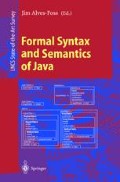Abstract
This chapter describes a machine checked proof of the type soundness of a subset of Java (we call this subset JavaS). In Chapter 3, a formal semantics for approximately the same subset was presented by Drossopoulou and Eisenbach. The work presented here serves two roles: it complements the written semantics by correcting and clarifying some details; and it demonstrates the utility of formal, machine checking when exploring a large and detailed proof based on operational semantics.1 This work contributes to three distinct fields of formal reasoning:
-
-The Formal Study of Java: We contribute a detailed analysis of a significant property of Java, and provide corrections to proofs that are interesting in their own right.
-
-Tools for Formal Methods: This work is a major case study in so-called ‘declarative’ proof techniques. The tool we use, called DECLARE [Sym97], has been developed by the author to demonstrate the utility of these techniques.
-
-Formally Checked Properties of Languages: This work contributes a tool and a methodology for the general task of machine checking properties of languages.
Most of this chapter should be clear to readers with a basic understanding of operational semantics, formal specification and the results presented in Chapter 3.
Access this chapter
Tax calculation will be finalised at checkout
Purchases are for personal use only
Preview
Unable to display preview. Download preview PDF.
References
Juanito Camilleri and Tom Melham. Reasoning with inductively defined relations in the HOL theorem prover. Technical Report 265, University of Cambridge Computer Laboratory, Cambridge, CB2 3QG, U.K., August 1992.
Sophia Drossopoulou and Susan Eisenbach. Is the Java type system sound? (version 2.01). Technical report, Imperial College, University of London, Cambridge, CB2 3QG, U.K., January 1997. This version was distributed on the Internet. Please contact the authors if a copy is required for reference.
James Gosling, Bill Joy, and Guy Steele. The Java Language Specification. Addison-Wesley, 1996.
M.J.C Gordon and T.F Melham. Introduction to HOL: A Theorem Proving Assistant for Higher Order Logic. Cambridge University Press, 1993.
John Harrison. HOL light: A tutorial introduction. In Mandayam Srivas and Albert Camilleri, editors, Proceedings of the First International Conference on Formal Methods in Computer-Aided Design (FMCAD’96), volume 1166 of Lecture Notes in Computer Science, pages 265–269. Springer-Verlag, 1996.
John R. Harrison. Proof Style. Technical Report 410, University of Cambridge Computer Laboratory, Cambridge, CB2 3QG, U.K., January 1997.
D. W. Loveland. Mechanical Theorem Proving by Model Elimination. Journal of the ACM, 15:236–251, 1968.
S. Owre, S. Rajan, J.M. Rushby, N. Shankar, and M.K. Srivas. PVS: Combining specification, proof checking and model checking. In Rajeev Alur and Thomas A. Henzinger, editors, Computer-Aided Verification, CAV’ 96, volume 1102, pages 411–414. Springer-Verlag, July/August 1996.
L. C. Paulson. Isabelle: The next 700 theorem provers. In P. Odifreddi, editor, Logic and Computer Science, pages 361–385. Academic Press, 1990.
Lawrence C. Paulson. A Fixed Point Approach to Implementing (Co)inductive Definitions. 18th International Conference on Automated Deduction, pages 148–161, 1994.
Roly Perera and Peter Bertelsen. The Unoffcial Java Bug Report, June 1997. Published on the WWW at http://www2.vo.lu/homepages/gmid/java.htm.
Gordon D. Plotkin. A structural approach to operational semantics. Technical report, Computer Science Department, Aarhus University, DK-8000 Aarhus C. Denmark, September 1991.
Zhenyu Qian. A Formal Specification of Java Virtual Machine Instructions. Technical report, UniversitÄt Bremen, FB3 Informatik, D-28334 Bremen, Germany, November 1997.
P. Rudnicki. An Overview of the MIZAR Project, 1992. Unpublished; available by anonymous FTP from menaik.cs.ualberta.ca as pub/Mizar/Mizar_Over.tar.Z.
Don Syme. DECLARE: A prototype declarative proof system for higher order logic. Technical Report 416, University of Cambridge Computer Laboratory, Cambridge, CB2 3QG, U.K., March 1997.
Author information
Authors and Affiliations
Editor information
Editors and Affiliations
Rights and permissions
Copyright information
© 1999 Springer-Verlag Berlin Heidelberg
About this chapter
Cite this chapter
Syme, D. (1999). Proving Java Type Soundness. In: Alves-Foss, J. (eds) Formal Syntax and Semantics of Java. Lecture Notes in Computer Science, vol 1523. Springer, Berlin, Heidelberg. https://doi.org/10.1007/3-540-48737-9_3
Download citation
DOI: https://doi.org/10.1007/3-540-48737-9_3
Published:
Publisher Name: Springer, Berlin, Heidelberg
Print ISBN: 978-3-540-66158-0
Online ISBN: 978-3-540-48737-1
eBook Packages: Springer Book Archive

